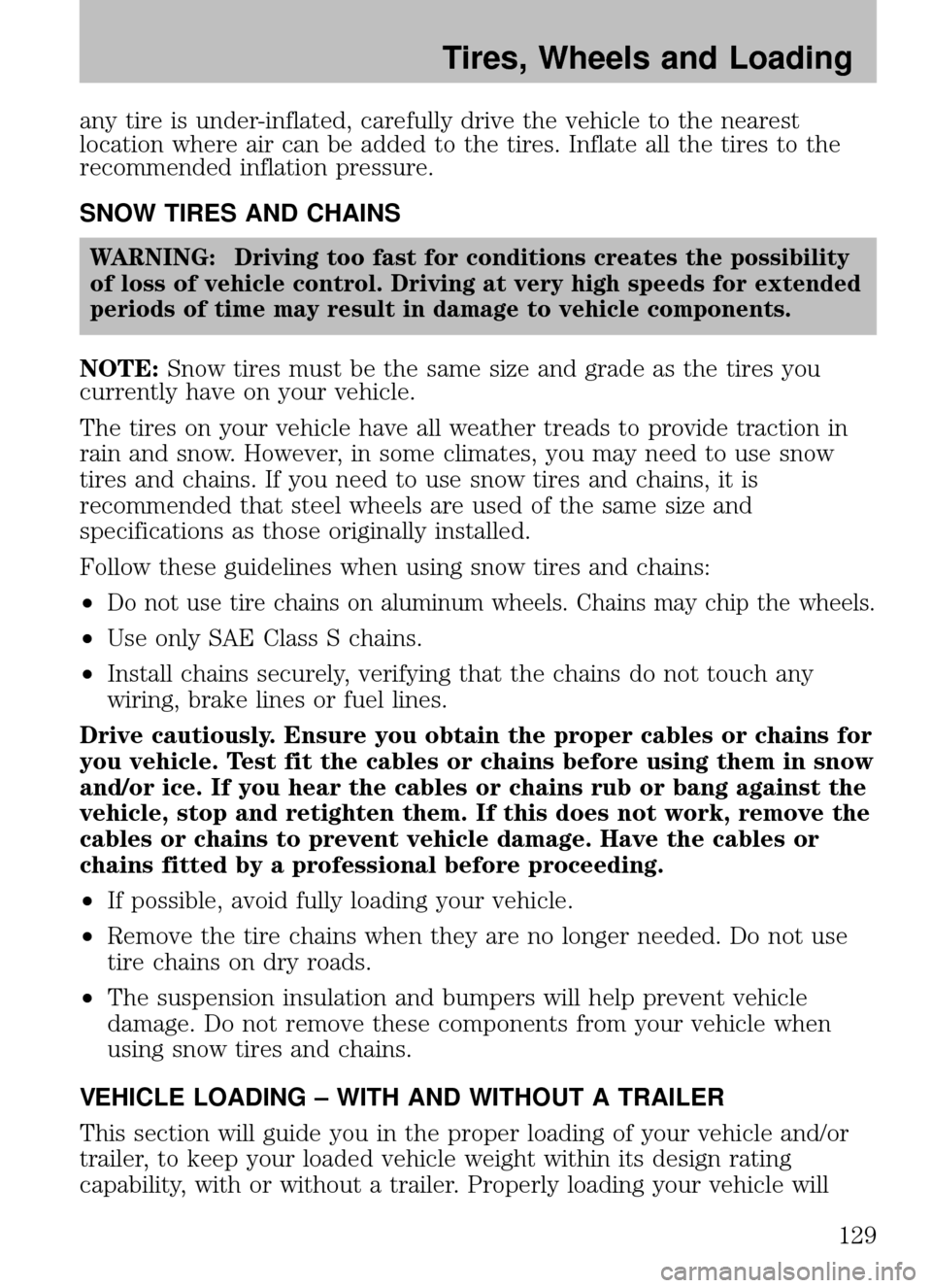2008 MAZDA MODEL B2300 TRUCK snow chains
[x] Cancel search: snow chainsPage 129 of 280

any tire is under-inflated, carefully drive the vehicle to the nearest
location where air can be added to the tires. Inflate all the tires to the
recommended inflation pressure.
SNOW TIRES AND CHAINS
WARNING: Driving too fast for conditions creates the possibility
of loss of vehicle control. Driving at very high speeds for extended
periods of time may result in damage to vehicle components.
NOTE:Snow tires must be the same size and grade as the tires you
currently have on your vehicle.
The tires on your vehicle have all weather treads to provide traction in
rain and snow. However, in some climates, you may need to use snow
tires and chains. If you need to use snow tires and chains, it is
recommended that steel wheels are used of the same size and
specifications as those originally installed.
Follow these guidelines when using snow tires and chains:
•
Do not use tire chains on aluminum wheels. Chains may chip the wheels.
• Use only SAE Class S chains.
• Install chains securely, verifying that the chains do not touch any
wiring, brake lines or fuel lines.
Drive cautiously. Ensure you obtain the proper cables or chains for
you vehicle. Test fit the cables or chains before using them in snow
and/or ice. If you hear the cables or chains rub or bang against the
vehicle, stop and retighten them. If this does not work, remove the
cables or chains to prevent vehicle damage. Have the cables or
chains fitted by a professional before proceeding.
•If possible, avoid fully loading your vehicle.
• Remove the tire chains when they are no longer needed. Do not use
tire chains on dry roads.
• The suspension insulation and bumpers will help prevent vehicle
damage. Do not remove these components from your vehicle when
using snow tires and chains.
VEHICLE LOADING – WITH AND WITHOUT A TRAILER
This section will guide you in the proper loading of your vehicle and/or
trailer, to keep your loaded vehicle weight within its design rating
capability, with or without a trailer. Properly loading your vehicle will
2008 B-Series (mbs)
Owners Guide (post-2002-fmt)
USA (fus)
Tires, Wheels and Loading
129
Page 180 of 280

WARNING: Refer toTire Pressure Monitoring System (TPMS)
in the Tires, Wheels and Loading chapter for important
information. If the tire pressure monitor sensor becomes
damaged, it will no longer function.
Dissimilar spare tire/wheel information WARNING: Failure to follow these guidelines could result in an
increased risk of loss of vehicle control, injury or death.
If you have a dissimilar spare tire/wheel, then it is intended for
temporary use only. This means that if you need to use it, you should
replace it as soon as possible with a road tire/wheel that is the same size
and type as the road tires and wheels that were originally provided by
Mazda. If the dissimilar spare tire or wheel is damaged, it should be
replaced rather than repaired.
A dissimilar spare tire/wheel is defined as a spare tire and/or wheel that
is different in brand, size or appearance from the road tires and wheels
and can be one of three types: 1. T-type mini-spare: This spare tire begins with the letter “T” for tire
size and may have “Temporary Use Only” molded in the sidewall
2. Full-size dissimilar spare with label on wheel: This spare tire
has a label on the wheel that states: “THIS TIRE AND WHEEL FOR
TEMPORARY USE ONLY”
When driving with one of the dissimilar spare tires listed above, do not:
• Exceed 50 mph (80 km/h)
• Load the vehicle beyond maximum vehicle load rating listed on the
Safety Compliance Label
• Tow a trailer
• Use snow chains on the end of the vehicle with the dissimilar spare
tire
• Use more than one dissimilar spare tire at a time
• Use commercial car washing equipment
• Try to repair the dissimilar spare tire
Use of one of the dissimilar spare tires listed above at any one wheel
location can lead to impairment of the following:
• Handling, stability and braking performance
2008 B-Series (mbs)
Owners Guide (post-2002-fmt)
USA (fus)
Roadside Emergencies
180
Page 181 of 280

•Comfort and noise
• Ground clearance and parking at curbs
• Winter weather driving capability
• Wet weather driving capability
For vehicles equipped with 4WD, it is not recommended that the vehicle
be operated in 4WD modes with a temporary emergency spare tire. If
4WD operation is necessary, do not operate above speeds of 10 mph
(16 km/h) or for distances above 50 miles (80 km). 3. Full-size dissimilar spare without label on wheel
When driving with the full-size dissimilar spare tire/wheel, do not:
• Exceed 70 mph (113 km/h)
• Use more than one dissimilar spare tire/wheel at a time
• Use commercial car washing equipment
• Use snow chains on the end of the vehicle with the dissimilar spare
tire/wheel
The usage of a full-size dissimilar spare tire/wheel can lead to
impairment of the following:
• Handling, stability and braking performance
• Comfort and noise
• Ground clearance and parking at curbs
• Winter weather driving capability
• Wet weather driving capability
• All-Wheel driving capability (if applicable)
• Load leveling adjustment (if applicable)
When driving with the full-size dissimilar spare tire/wheel additional
caution should be given to:
• Towing a trailer
• Driving vehicles equipped with a camper body
• Driving vehicles with a load on the cargo rack
Drive cautiously when using a full-size dissimilar spare tire/wheel and
seek service as soon as possible.
2008 B-Series (mbs)
Owners Guide (post-2002-fmt)
USA (fus)
Roadside Emergencies
181
Page 273 of 280

Spark plugs, specifications .......264
Special noticeambulance conversions ..............7
utility-type vehicles ....................7
Specification chart,
lubricants ...................................260
Speed control ..............................57
Starting your
vehicle ........................146–147, 149 jump starting ..........................189
Steering wheel tilting .........................................54
T
Tether anchors ..........................102
Tilt steering wheel ......................54
Tire Pressure Monitoring
System (TPMS) Roadside Emergencies ...........179
Tires, Wheels and Loading ....124
Tires ...........................108–109, 179 alignment ................................117
care ..........................................113
changing ..........................179, 184
checking the pressure ............113
inflating ...................................110
label .........................................123
replacing ..................................114
rotating ....................................117
safety practices .......................116
sidewall information ...............119
snow tires and chains ............129
spare tire .................................180
terminology .............................110
tire grades ...............................109
treadwear ........................109, 113
Towing .......................................135 recreational towing .................144
trailer towing ..........................135
wrecker ....................................195
Traction-lok rear axle ...............155
Transfer case fluid checking .........................257
Transmission automatic operation ...............156
brake-shift interlock (BSI) ....156
fluid, checking and adding
(manual) .................................256
lubricant specifications ..........260
manual operation ....................159
Turn signal ..................................46
V
Vehicle Identification Number
(VIN) ..........................................266
Vehicle loading ..........................129 camper bodies ........................145
Ventilating your vehicle ...........149
W
Warning chimes ...........................17
Warning lights (see Lights) .......12
Washer fluid ..............................226
Water, Driving through .............167
Windows power .........................................55
Windshield washer fluid and
wipers ..........................................53 checking and adding fluid .....226
checking and cleaning ............226
replacing wiper blades ...........227
Wrecker towing .........................195
2008 B-Series (mbs)
Owners Guide (post-2002-fmt)
USA (fus)
Index
273